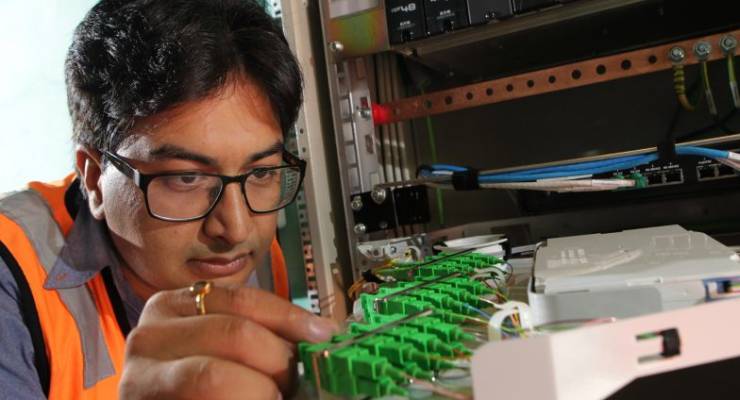
The extent to which the government’s decision to force NBN to switch to Malcolm Turnbull’s Multi-Technology Mix model will expose it to financial disaster has become clearer this week from Telstra head Andy Penn’s comments about his 5G rollout.
As Crikey reported in April, 5G is superior to NBN’s mishmash of fibre-to-the-node and HFC cable, now being built at the direction of Malcolm Turnbull when the Coalition took power in 2013. It has previously been unclear what kind of impact 5G would have on this second-rate NBN. Now, Penn has provided some specific numbers on that, and it’s deeply scary for NBN.
NBN’s financial performance relies on a 73-75% take-up rate for its services — that is, 73-75% of premises in Australia will end up using an NBN service. The 25-27% that do not are a mix — according to NBN:
- “Not every premises in Australia is expected to want access to the nbn network, e.g. holiday homes.
- Some premises with lower data needs are expected to choose to use mobile only products.
- Some premises may use fibre alternatives / nbn network wholesale competitors”
In previous years, NBN provided a breakdown of this in its corporate plan: empty premises, 8.5-9.5%; mobile-only, 15-16%, alternative fibre, 1.5%. In its corporate plan last year, however, this breakdown mysteriously vanished. It’s now becoming clear why.
This week, Penn said that 5G was likely to increase the level of mobile-only households by 10-15 percentage points from current 15% levels — meaning the level of mobile-only households will grow to 25-30%. Even under Penn’s low-growth 5G scenario, NBN’s take-up rate will fall to 65%, and could be as low as 60%. That will be catastrophic for its revenue.
NBN is already financially problematic as an asset earning a return for the government, courtesy of its need to reduce its wholesale prices in the face of fierce criticism about poor speeds and network congestion. A dramatic fall in its forecast take-up rate will wreck its financial forecasts. This week has already revealed that its rollout is set to slow even further and may miss the 2020 scheduled completion date — although, ironically, this means lower payments to Telstra.
The company is sticking to its 15% mobile forecast. “Even the mobile operators themselves have acknowledged that the nbn network will continue to serve the vast majority of the market,” a spokesperson told Crikey. “We expect 15 per cent of premises will be wireless-only. We keep a very close eye to see if it will stay true. Our estimates have not changed but we continue monitoring.”
NBN also argues that any impact will take significant time. “Delivering national 5G network coverage will require mobile operators to build out fibre much deeper into the network – this is likely to take a considerable time to achieve given the amount of work involved.”
Nonetheless, NBN’s next corporate plan in August looks set to be a truth-telling moment for a company forced to embrace the Coalition’s cynical policy — and one that may force Turnbull to finally confront the financial consequences of his appalling stewardship of broadband in Australia.








I did not choose to take up the NBN. I was blackmailed into it because they were disconnecting my phone.
NBN will be the greatest of Malcolm Turnbull’s negative legacy. He cannot be forgiven for turning what was a visionary nation-building project that would have given Australia substantial social advantages and limitless business opportunities into an embarrassing mess. And now BK points out that mess is a high probability of going broke. The sooner this country can get rid of Turnbull and his insane hard-right puppet masters, the better chance we have of recovering from the social damage being done by this inept LNP government.
Bernard, they said the same thing about 4G. Also 5G is going to require an antenna every few hundred metres – good luck rolling that one out. NBN’s value as a wired maximum capacity transporter has probably gone up because of the end of net neutrality in the last few weeks in the US (something Australian media seems to have missed) and just watch the Comcast/AT&T merger as a guide to how a monopoly wired provider can screw the consumer and now the content providers. Australia’s best bet for us all is to complete fibre to the home and then control NBN as a public “natural” monopoly.
Hear! Hear! 3 Policy Options. Nothing could be more crucial for Australia, constituted by a relatively small population spread out over thousands of kilometres and thousands of kilometres from most outs nations, in a world where information technology is becoming the dominant means of production, than Australians owning our own world-class backbone network. But public ownership is a heresy to the right wing wonks in the LNP.
Except for coal fired power stations!
Indeed
Agree BeenAround, we should have all our essential services in public hands, anything else is against the public interest. It would be to voters’ advantage to be wary of governments who sell their populations up the river and privatize their paddles.
We should look and vote for people/parties with public ownership as an important part of their platform.
Why do you say 5G is a threat because of the mish-mash Coalition model NBN, and imply that the original FTTP model would have been okay? From what I’ve read, 5G offers 1GB+ speeds, which is at least as fast as FTTP. So why wouldn’t 5G have been a threat to the (vastly more expensive and slower to deliver, but you never mention that) Labor NBN?
Is it not the case that wireless, including 5G will always have capacity constraints, albeit that increasing speed is available. Fibre gives you much more capacity (a much bigger pipe) into the future.
Turnbull, the hollow man, serving his masters.
Spot on. Where has the money gone? or perhaps, to whom?